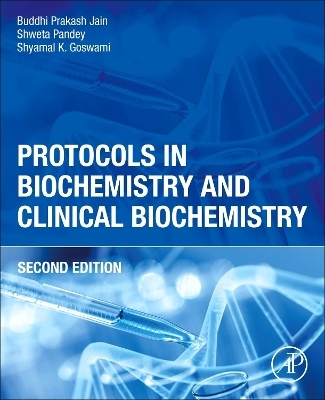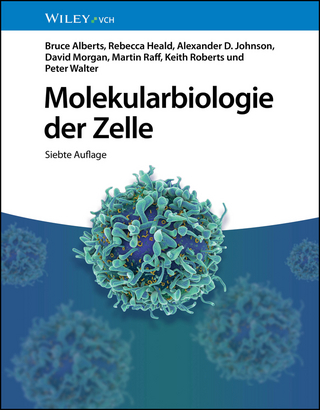
Protocols in Biochemistry and Clinical Biochemistry
Academic Press Inc (Verlag)
978-0-443-13945-1 (ISBN)
Dr. Buddhi Prakash Jain is an Assistant Professor at the Department of Zoology, Mahatma Gandhi Central University, Motihari, Bihar, India. He completed his doctoral studies at the School of Life Sciences, Jawaharlal Nehru University (JNU) New Delhi, India. His research interests include gene expression regulation and endoplasmic reticulum stress in cancer. He is the recipient of several awards including a gold medal in Master Programme (M.Sc.), EMBO travel award, DST (Department of Science and Technology) Govt of India, Young Scientist travel award, and has published several papers in reputed international journals and a number of books and book chapters. Shweta Pandey is an Assistant Professor at the Department of Biotechnology, Govt VYT PG Autonomous College, Durg Chhatisgarh, India. Dr. Pandey received a PhD from the School of Life Sciences, Jawaharlal Nehru University (JNU) New Delhi, India. She has vast teaching experience and has published several papers in reputed international journals, many book chapters in edited books, and co-edited Protocols in Biochemistry and Clinical Biochemistry (Elsevier, 2020). Her research interests include cell cycle regulation, molecular and cell mechanisms of tumor cells, and cancer biology. Shyamal Goswami has a research career spanning 35 years. He has experience teaching in biochemistry, cellular and molecular biology and redox biology at the postgraduate level. He served as Associate Professor and Professor in the School of Life Sciences at Jawaharlal Nehru University, India, from 1998 to 2020. Prior to this he was a Research Assistant Professor in the Department of Anatomy and Cell Biology at the State University of New York-Health Science Centre at Brooklyn, New York, USA. Dr. Goswami has contributed numerous publications across his field and has more than 1500 citations. He also co-authored Protocols in Biochemistry and Clinical Biochemistry and co-edited Post-transcriptional Gene Regulation in Human Disease, both published by Academic Press/Elsevier. His main areas of research are cell signaling and gene expression in the cardiovascular system; redox biology of degenerative diseases; and signal scaffolds and cell functions.
Solutions, Acids and Bases
1. Preparation of Solutions
2. Acid and Base
Carbohydrates
3. Determination of the presence of carbohydrates in the given sample by Molisch’s test
4. Determination of the presence of reducing carbohydrates in the given sample by Picric acid test
5. Determination of the presence of reducing carbohydrates in the given sample by Fehling’s test
6. Determination of the presence of reducing carbohydrates in the given sample by Benedict’s test
7. Determination of the presence of reducing carbohydrates in the given sample by Tommer’s test
8. Determination of the presence of reducing carbohydrates in the given sample by Nylander’s test
9. Distinguish between monosaccharides and reducing disaccharides by Barfoed’s test.
10. Distinguish between aldose and ketose by Seliwanoff’s test.
11. Determination of pentose sugar by Bial’s test
12. Determination of the presence of galactose in a test sample by the Mucic acid test
13. Differentiation between the presence of ketohexose or aldohexose in the test sample by Foulger'stest
14. Determination of the presence of reducing carbohydrates in the given sample by Fearon’s methylamine test
15. Confirmation of the presence of reducing carbohydrates in the given sample by osazone formation test
16. Determination of the presence of polysaccharides in the given sample by an iodine test
17. Quantitative estimation of carbohydrates in the given sample by anthrone test.
18. Quantitative estimation of reducing carbohydrates in the given sample by 3,5-dinitro salicylic acid (DNSA) test.
19. Extraction and estimation of glycogen from the liver and muscle of the well-fed and starved rat.
20. Separation and Identification of sugars present in fruit juices using thin-layer chromatography (TLC).
21. Extraction and analysis of soluble carbohydrates from plants.
Lipids
22. Solubility test for lipids
23. Emulsion test for lipids.
24. To determine the degree of unsaturation of fatty acids
25. Determination of the saponification value of the given fat/ oil sample
26. To determine the fatty acid value of fat
27. Acrolein test for the presence of glycerol
28. Libermann – Buchard test for detection of cholesterol.
29. Extraction of lipid from leaves (Bligh and Dyer’s method and single extraction method).
30. Extraction of lipid from egg yolk and estimation of phosphorous content in it
31. Extraction of lipid from tissues (Folch method).
32. Identification of lipids by TLC.
33. Lipid per oxidation measurement by Thiobarbituric acid (TBA) assay.
Proteins
34. Isolation of protein from animal cells/tissue using RIPA buffer
35. Qualitative test for Proteins and amino acids
36. Estimation of proteins by Biuret method
37. Estimation of proteins by Bradford method
38. Estimation of proteins by Bicinchoninic acid (BCA) method
39. Estimation of proteins by Folin-Lowry method
40. Estimation of proteins by UV spectrophotometric method
41. Protein separation by gel electrophoresis under denaturing condition (SDS-PAGE)
42. Separation of amino acids by paper chromatography.
Minerals
43. Estimation of the Calcium in water or milk by EDTA titrimetric method
44. Estimation of the Calcium in serum by O-Cresolpthaleincomplexon method (colorimetric)
45. Estimation of the inorganic phosphorus by colorimetric method
46. Estimation of the Iron by thiocyanate colorimetric method
47. Estimation of the Chloride by Titration method (Mohr Argentometric method)
Vitamin
48. Estimation of Vitamin A by Trichloroacetic acid (modified Carr-Price method)
49. Estimation of the Tocopherol (Vitamin E) by colorimeter (Baker and Frank method)
50. Estimation of the Thiamine (Vitamin B1) by Thiochrome technique
51. Estimation of the Ascorbic acid (Vitamin C) by 2,6-dichlorophenol indophenol (DCPIP) method (Titrimetric)
52. Estimation of the Ascorbic acid (Vitamin C) by 2, 4 Dinitrophenylhydrazine method (Colorimetric)
Enzymes
53. To study the effect of pH and temperature on the action of salivary amylase.
54. Determination of the activity of amylase enzyme (crude) extracted from sweet potato.
55. Determination of the specific activity of the amylase enzyme.
56. To determine Vmax and Km in of the amylase enzyme.
Nucleic acid
57. Determination of the amount of DNA present in the solution by diphenylamine (DPA) method
58. Determination of the amount of RNA present in the solution by orcinol method.
59. Isolation of plasmid DNA using the alkaline lysis method.
60. Preparation of plasmid DNA using boiling lysis method.
61. Plasmid DNA purification using polyethylene glycol.
62. Isolation of genomic DNA of the unknown bacterial strain.
63. Isolation of DNA from plant tissue.
64. Isolation of DNA from a eukaryotic cell using proteinase K and phenol.
65. Isolation of DNA from a eukaryotic cell.
66. Separation of bands of DNA by agarose gel electrophoresis.
67. SOUTHERN TRANSFER AND HYBRIDIZATION: To perform Southern blotting of the genomic DNA.
68. Isolation of RNA from animal cells.
69. NORTHERN BLOTTING.
Clinical Biochemistry
70. Determination of Serum Urea [Diacetyl Monoxime (DAM) Method],
71. Estimation of Uric Acid in Serum Sample (Uricase Method),
72. Estimation of Creatinine in Serum Samples (Jaffe’s Method),
73. Determination of Serum Glutamate Pyruvate Transaminase (SGPT) Activity,
74. Determination of Serum Glutamate Oxaloacetate Transaminase (SGOT) Activity,
75. Colorimetric Estimation of Alkaline Phosphatase (ALP) From Serum (King and Armstrong),
76. Estimation of Serum Albumin by the Dye-Binding Method (Bromocresol Green Method),
77. Estimation of Blood Glucose by the Glucose Oxidase Method,
78. Estimation of Glucose in Urine by Benedict Method,
79. Estimation of Percentage of Glucose (Reducing Sugars) in Urine (by Benedict Titration Method),
80. Oral Glucose Tolerant Test (OGTT),
81. Estimation of Total Cholesterol in Serum (Watson Method),
82. Estimation of Total Cholesterol in Serum (Enzymatic Method),
83. Estimation of Triglycerides in Serum (Enzymatic Method),
84. Estimation of Hemoglobin in the Blood (Sahli’s Method).
85. Determination of serum amylase.
86. Catalase activity assay.
87. Superoxide dismutase (SOD) assay.
Plant Biochemistry
88. Qualitative analysis of plant secondary metabolites.
89. Qualitative analysis of photochemical.
90. Quantitative estimation of secondary metabolites.
91. Estimation of Chlorophyll contents.
92. Determination of starch
| Erscheinungsdatum | 09.11.2024 |
|---|---|
| Verlagsort | San Diego |
| Sprache | englisch |
| Maße | 191 x 235 mm |
| Gewicht | 450 g |
| Themenwelt | Naturwissenschaften ► Biologie ► Biochemie |
| Naturwissenschaften ► Physik / Astronomie ► Angewandte Physik | |
| Technik ► Umwelttechnik / Biotechnologie | |
| ISBN-10 | 0-443-13945-8 / 0443139458 |
| ISBN-13 | 978-0-443-13945-1 / 9780443139451 |
| Zustand | Neuware |
| Haben Sie eine Frage zum Produkt? |
aus dem Bereich


